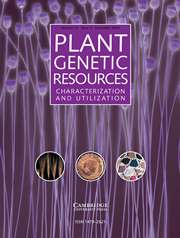Article contents
Genetic differences in macro-element mineral concentrations among 52 historically important tomato varieties
Published online by Cambridge University Press: 13 March 2018
Abstract
Tomato (Solanum lycopersicum) fruit quality and yield are highly dependent on adequate uptake of nutrients. Potassium, magnesium and calcium are essential elements that influence fruit quality traits such as colour, uniformity of ripening, hollow fruit, fruit shape, firmness and acidity. Sodium is not an essential element for tomato and can detrimentally compete with the absorption of potassium and calcium. Daily intakes of potassium, magnesium and calcium in human diets are typically below healthful levels, while sodium intake is often excessive. The objective of this study was to compare 52 diverse commercially important varieties of tomato for concentrations of potassium, magnesium, calcium and sodium in fruits. The tomatoes were produced in replicated plots in Geneva, NY in 2010 and 2011. Multiple fruits per plot were harvested vine-ripe, homogenized and assayed for cations. Analysis of variance showed significant differences among the 52 varieties for all four traits, i.e. cation concentrations (df = 51, P < 0.0001–0.0034) and no significant differences between years for any trait (df = 1, P = 0.3432–0.6770). Factor analysis showed a strong interrelationship between potassium and magnesium that was independent of calcium and sodium. Potassium and magnesium were highly significantly correlated with each other (r = 0.64, P < 0.0001). No other correlations between pairs of traits were observed. Results supported a genetic basis for potassium, magnesium, calcium and sodium concentrations that was consistent across environments (i.e. years). Results can contribute to the development of cultivars with favourable cation profiles in terms of human health and fruit quality.
- Type
- Research Article
- Information
- Creative Commons
- This is a work of the U.S. Government and is not subject to copyright protection in the United States.
- Copyright
- Copyright © NIAB 2018
Footnotes
These authors contributed equally to this work.
Author is deceased.
References
- 7
- Cited by


